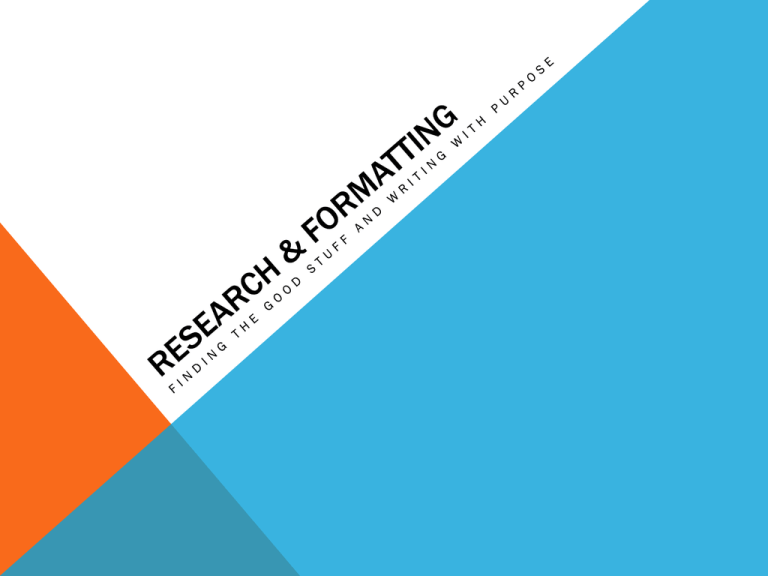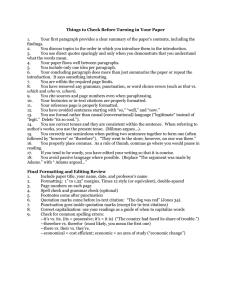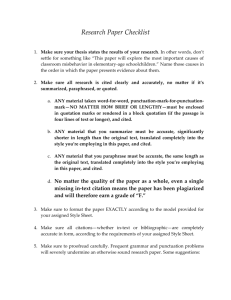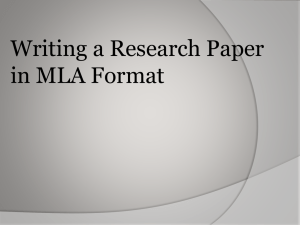Document 14279518
advertisement

GETTING STARTED Research is difficult. If you don’t know what you’re looking for you can spend hours just ‘surfing’ You need a ‘search toolbox’ – list of starter sites you can return to again and again – Recommended Print and Online Resources from the school is one on these lists Your public library is just a mouse click away and has a great selection of databases. A database is a great place to start since it takes away the worry about credible sources. Anyone can create a website so you must know how to assess a website as a reliable source. ASSESSING WEBSITES When you find a website that you think has relevant information consider the following criteria: Authority/Credibility Content Bias/Purpose Usability/Design AUTHORITY Ask yourself these questions: Who is the author/creator of this site? Is the author a specialist/expert in the field? Do they have the qualifications to write about this subject? Should I believe them? Is it difficult to determine who the author may be? Remember, if someone knows what they’re talking about they are probably proud of it! Is the site current? If you are researching a topic that can change be sure the site you’re looking at is up to date. CONTENT Ask yourself these questions: What other topics are included in the information? Does the website information match what you really need or is it a stretch? Does the website information go into great depth? Is the website ‘scholarly’ enough for a senior credit class? Can you examine the website for other sources? Are there link that are well chosen and relevant? Well maintained sites always have links that work! BIAS AND PURPOSE Ask yourself these questions: Why was this site created? Does the author /creator indicate that he or she wanted to persuade, sell, promote or explain and inform? An author that is trying to sell you something is not a credible source! Are the intentions of the author/creator clearly stated? Remember to carefully examine the website to be sure you aren’t being tricked by anyone. Are both sides of an issue presented? What is the domain? Org, com, net. This information will help you determine the intended audience. DESIGN Ask yourself the following questions: Is this a user friendly site? Are there graphics that are easy to follow but add depth to the content? Are there errors in grammar and spelling? FINAL ANALYSIS Being aware of the importance of a website’s author, content, bias and design you will be prepared to view a website through a critical lens and the more you practice this skill the better and quicker you will become making your research stage less stressful . FROM RESEARCH TO WRITING Once you have gathered your information you will begin the writing process. This process is different for everyone, but a consistent format following MLA guidelines for the final product should always be acknowledged. FORMAT: GENERAL GUIDELINES Type on white 8.5” x 11” paper Double-space everything Use 12 pt. Times New Roman font (or similar font) Leave one to two spaces after punctuation Set all margins to 1 inch on all sides Indent the first line of paragraphs one half-inch FORMAT: GENERAL GUIDELINES CONTINUED Header with page numbers in the upper right corner Italicize the names of books, plays, poems published as books, pamphlets, periodicals, web sites, online databases, films, television and radio broadcasts, compact discs, audiocassettes, record albums, dance performances, operas and other long musical compositions, works of visual art, ships, aircraft and spacecraft. Example The Awakening Use quotation marks for the titles of articles, essays, stories and poems published within larger works, chapters of books, pages in Web sites, individual episodes of television and radio broadcasts, and short musical compositions. Example “The Lottery” Endnotes go on a separate page before your Works Cited page FORMATTING THE 1ST PAGE • Do not include a title page • Be sure to double space everything • In the upper left corner of the 1st page, list your name, your instructor's name, the course, and date • Center the paper title (use standard caps but no underlining, italics, quote, or bold) • Create a header in the upper right corner at half an inch from the top and one inch from the right of the page (include your last name and page number) SAMPLE 1ST PAGE IN-TEXT CITATIONS: THE BASICS • MLA uses parenthetical citations • Parenthetical citations depend on the medium (e.g. Print, Web, DVD) • Parenthetical citations also depend on the source’s entry on the Works Cited page Citation Punctuation You should reproduce internal punctuation exactly as in the original. The closing punctuation, though, depends on where the quoted material appears in your sentence. Suppose for example, that you want to quote the following sentence: “You’ve got to be carefully taught.” If you begin your sentence with this line, you have to replace the closing period with a punctuation mark appropriate to the new context. “You’ve got to be carefully taught,” wrote Oscar Hammerstein… If the quotation ends with a question mark or an exclamation point, however, the original punctuation is retained, and no comma is required. Commas and periods that directly follow quotations go inside the closing quotation marks, but a parenthetical reference should intervene between the quotation and the required punctuation. Thus, if a quotation ends with a period, the period appears after the reference. AUTHOR-PAGE STYLE In-text Example: Wordsworth stated that Romantic poetry was marked by a "spontaneous overflow of powerful feelings" (263). Romantic poetry is characterized by the "spontaneous overflow of powerful feelings“ (Wordsworth 263). Wordsworth extensively explored the role of emotion in the creative process (263). Corresponding Works Cited Entry: Wordsworth, William. Lyrical Ballads. London: Oxford U.P., 1967. Print. PRINT SOURCE WITH AUTHOR In-text Example: Human beings have been described by Kenneth Burke as "symbol-using animals" (3). Human beings have been described as "symbol-using animals" (Burke 3). Corresponding Works Cited Entry: Burke, Kenneth. Language as Symbolic Action: Essays on Life, Literature, and Method. Berkeley: U of California P, 1966. Print. FORMATTING LONG QUOTATIONS In-text Example: Nelly Dean treats Heathcliff poorly and dehumanizes him throughout her narration: They entirely refused to have it in bed with them, or even in their room, and I had no more sense, so, I put it on the landing of the stairs, hoping it would be gone on the morrow. By chance, or else attracted by hearing his voice, it crept to Mr. Earnshaw's door, and there he found it on quitting his chamber. Inquiries were made as to how it got there; I was obliged to confess, and in recompense for my cowardice and inhumanity was sent out of the house. (Bronte 78) ADDING/OMITTING WORDS In-text Example for Adding Words: Jan Harold Brunvand, in an essay on urban legends, states: "some individuals [who retell urban legends] make a point of learning every rumor or tale" (78). In-text example for Omitting Words: In an essay on urban legends, Jan Harold Brunvand notes that "some individuals make a point of learning every recent rumor or tale . . . and in a short time a lively exchange of details occurs" (78). CITING SHAKESPEARE • If you quote dialogue between two or more characters in a play, set the quotation off from your text. • Begin each part of the dialogue with the appropriate character’s name indented one inch (or ten spaces) from the left margin and written in all capital letters: MACBETH. • Follow the name with a period, and start the quotation. • Indent all subsequent lines in that character’s speech an additional quarter inch (or ten spaces). • When the dialogue shifts to another character, start a new line indented one inch (or ten spaces) from the left margin. • A short time later Lear loses the final symbol of his former power, the soldiers who make up his train: GONERIL. Hear me, my lord. What need you five-and-twenty, ten or five, To follow in a house where twice so many Have a command to tend you? REGAN. What need one? LEAR. O, reason not the need! (King Lear 2.4.254-58) WORKS CITED PAGE: THE BASICS FINAL RULE ALWAYS follow your instructor’s guidelines! WORKS CITED Gibaldi, Joseph. MLA Handbook for Writers of Research Papers. New York: Modern Language Association of America, 2009. Print




